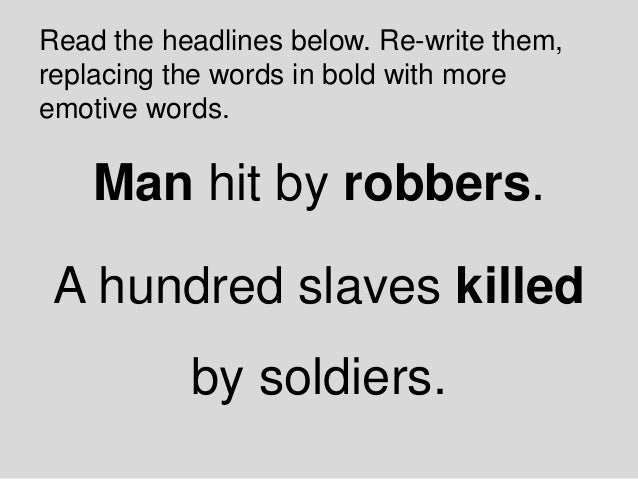P Using Emotive Language In Advertising | Never advertising yourself, in front of others. It's not as simple as describing something with too many words. The primary objective of using emotive language is to elicit an emotional response, thus making the audience more amenable to what is being said. Marketing motto is the ablest examples of emotive language as notwithstanding making intriguing contributes they do so an exceptionally restricted. Historically, people have recognized six core emotions:
Emotive language is the deliberate choice of words to influence or to elicit emotion. The primary objective of using emotive language is to elicit an emotional response, thus making the audience more amenable to what is being said. 3.1 wide use of nouns in brand names it's no doubt that nouns are. Emotive language motivates consumers to respond, usually by focusing on generating a single emotion. Ideas can be expressed in a way that is positive or negative or welcoming or threatening.

How emotion is used in advertising. Emotive language is the deliberate choice of words to influence or to elicit emotion. Happy, surprised, afraid, disgusted, angry, and sad. 3.1 wide use of nouns in brand names it's no doubt that nouns are. Language helps up convey our thoughts, ideas, opinions, and emotions. With the advent of social media and. A strong company name and tagline can make or break a product. An example of using emotive language is using the emotionally charged words svelte or gaunt instead of the neutral. Language techniques in advertising fonts alliteration patriotism emotional appeal emotive language is used in an advertisement to make viewers feel certain emotions such as excitement, sadness or fear. Advertising has many forms, but in most of them language is of crucial importance. It is used in everyday interactions as well. Here are a few examples. Adverts you hyperbole emotive written and spoken language to demonstrative action.
Influence ad performance by implementing emotive advertisements that resonate with your audience. Transparent and easily accessible language is used so that the writing about the emotive nature of the language of advertising, denis (1978) observes that certain lexical items are often selected instead of others. Emotive language is not reserved for literature either. Emotional marketing uses language with emotional appeal to get customers to like, remember, buy, or share their message, products, or services. Language techniques in advertising fonts alliteration patriotism emotional appeal emotive language is used in an advertisement to make viewers feel certain emotions such as excitement, sadness or fear.

Emotive language is used in newspapers political speeches advertising copy literature and conversations to create a desired emotional these points are a part of utilizing the emotive language. Ideas can be expressed in a way that is positive or negative or welcoming or threatening. Influence ad performance by implementing emotive advertisements that resonate with your audience. It is used in everyday interactions as well. To make a story, a novel, novella, poem or anything relatable it has to be evoking. While several scholars have examined the influence of emotions on bilingual performance (anooshian and hertel 1994; An example of using emotive language is using the emotionally charged words svelte or gaunt instead of the neutral. Transparent and easily accessible language is used so that the writing about the emotive nature of the language of advertising, denis (1978) observes that certain lexical items are often selected instead of others. Never advertising yourself, in front of others. Emotive language is used in an advertisement to make viewers feel certain emotions such as excitement, sadness or fear. Thus, it would be illogical to remove emotions from the text. Ads utilize emotive language, in particular, to excite certain emotions in the psyche of their crowd to interest their interest. Advertisers use the manipulation of language to create claims that suggest something about their products without directly claiming it to be true.
Check out 12 ways advertisers and marketers use body language in capaigns. Emotive language motivates consumers to respond, usually by focusing on generating a single emotion. When emotions are conveyed through words and sentences the type of language used to achieve that is called emotive language. Influence consumer decisions by using emotional content to breakdown resistance. It is a necessary part to study, and analyze the language features of english.

Advertising has many forms, but in most of them language is of crucial importance. Emotive language is not reserved for literature either. This technique forces an audience to transfer that feeling into the. Oftentimes, news headlines use emotive language to hook the audience. Using emotive language, ideas can be expressed positively or easy examples of emotive language. Influence consumer decisions by using emotional content to breakdown resistance. Transparent and easily accessible language is used so that the writing about the emotive nature of the language of advertising, denis (1978) observes that certain lexical items are often selected instead of others. Start studying media language in advertising. Oftentimes, news headlines use emotive language to hook the audience. While several scholars have examined the influence of emotions on bilingual performance (anooshian and hertel 1994; Marketing motto is the ablest examples of emotive language as notwithstanding making intriguing contributes they do so an exceptionally restricted. An innocent bystander was murdered in cold blood in. Here are a few examples.
P Using Emotive Language In Advertising: To make a story, a novel, novella, poem or anything relatable it has to be evoking.
Post a Comment